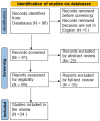Application of Aquaporins as Markers in Forensic Pathology: A Systematic Review of the Literature
- PMID: 38473914
- PMCID: PMC10932096
- DOI: 10.3390/ijms25052664
Application of Aquaporins as Markers in Forensic Pathology: A Systematic Review of the Literature
Abstract
The study of aquaporins (AQPs) in various forensic fields has offered a promising horizon in response to the need to have reliable elements for the identification of the manner of death and for the individuation of forensic markers for the timing of lesions and vitality of injury. In the literature, various tissues have been studied; the most investigated are the lungs, brain, kidneys, skin, and blood vessels. A systematic literature review on PubMed following PRISMA 2020 guidelines enabled the identification of 96 articles. In all, 34 of these were enrolled to identify Aquaporin-like (AQP-like) forensic markers. The analysis of the literature demonstrated that the most significant markers among the AQPs are as follows: for the brain, AQP4, which is very important in brain trauma and hypoxic damage; AQP3 in the skin lesions caused by various mechanisms; and AQP5 in the diagnosis of drowning. Other applications are in organ damage due to drug abuse and thrombus dating. The focus of this review is to collect all the data present in the literature about the forensic application of AQPs as forensic markers in the most important fields of application. In the current use, the individuation, validation, and application of markers in forensic investigation are very useful in real forensic applications in cases evaluated in court.
Keywords: aquaporins; forensic pathology; immunohistochemical markers.
Conflict of interest statement
The authors declare no conflict of interest.
Figures
References
Publication types
MeSH terms
Substances
LinkOut - more resources
Full Text Sources




